Tenerife Airport Disaster, 1977.
.jpg)
KLM Boeing 747-206B, reg. PH-BUF (Jumbo Jet).
%20named%20Clipper%20victor%202.jpg)
Pan Am “Clipper Victor”, Boeing 747-121, reg. N736PA. (Jumbo Jet).
On March 26, 1977, at 1:29 pm, Pan Am flight 1736 had left Los Angeles for a flight to Las Palmas, Gran Canaria, Spain. On board there were 380 charter travelers and 16 in the crew. They stopped in New York where the plane's crew was replaced.
On March 27, 1977, at 9:00 am, KLM flight 4805 took off from Amsterdam for a flight to Las Palmas. On board there were 234 charter travelers and 14 in the crew.
When the planes were in the air, they were told that a terrorist attack had been directed at Las Palmas Airport. A bomb had exploded. It was feared that another bomb was deployed. The planes that were on the way to Las Palmas were therefore redirected to Los Rodeos Airport at Tenerife. The small airport was quickly congested. The air traffic controllers ordered the incoming planes to park on the available spaces. This meant that most of the taxiways were blocked by incoming planes. Pan Am flight 1736 and KLM flight 4805 had landed at Los Rodeos. The passengers on Pan Am remained on the plane during the stop while KLM's were transported by bus to the terminal. They were now awaiting a message that Las Palmas airport would open again. Just before 5 pm, they were told to prepare for departure to Las Palmas.
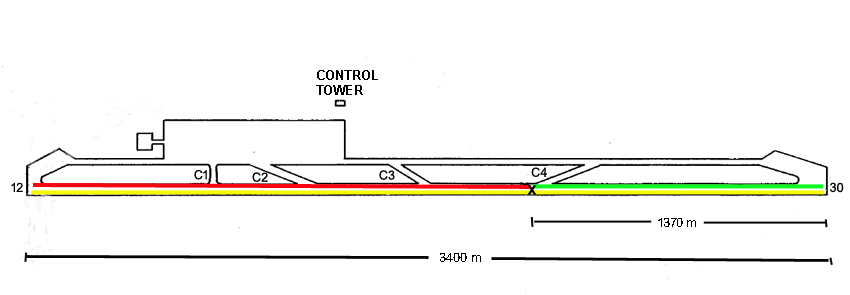
Los Rodeos Airport at Tenerife in 1977. Length of runway = 3400 m. Width = 45 m.
The yellow line: The KLM plane taxied from runway 12 to runway 30.
The red line: The Pan Am plane taxied from runway 12 to the collision site at taxiway C4.
The green line: The KLM plane's take-off distance to the collision site (1370 m).
X = the collision site.
The meteorological conditions were:
Intermittent showers. Fog.
Wind, 6 m / second.
Temp. 14° C
The airport's runway is located at 633 meters above the sea level. When the cloud base is at this altitude above Tenerife, the airport can be swept in by the clouds. The visibility conditions can then deteriorate quickly. The fog that is formed usually has a low density because it is formed at a height of about 600 m. It can therefore be dissolved as quickly as it came. At the time of the disaster, the control tower did not have sufficient visibility to see the planes on the runway. There was no ground radar at Los Rodeos.
In the following transcripts of the radio communication between the Control Tower and the planes, I have selected the most important sequences from 16:56 until the collision.
In the queue for the runway, KLM was just before Pan Am.
At 16:56, KLM contacted the Control Tower (Tower) to get the clearance to taxi on runway 12.
16:58, KLM got clearance to taxi down to runway 30 (the yellow line). When the runway is used as a taxiway it is called "backtrack". This action was necessary as most of the taxiways were blocked by other planes.
17:02, Pan Am contacts the Tower to get a clearance to taxi on runway 12. The tower confirms that Pan Am will taxi down to runway 30 (the red line) and that they will leave the runway at taxiway C3, on the left.
17:02:51, The Tower contacted KLM and asked how many exits they passed.
17:02:56, KLM answers that they think they have just passed taxiway C4.
17:03:29, Pan Am contacts the Tower and want confirmation that they will leave the runway at taxiway C3.
17:03:36, The Tower confirms that Pan Am will leave the runway at the third exit on the left.
17:03:47, The Tower asks Pan Am to report when they have left the runway.
17:04:58, The Tower contacts Pan Am and KLM. They are told that the lights that mark the center line of the runway do not function.
17:05:44, KLM asks the Tower to get take-off clearance.
17:05:53, The Tower responds by providing clearance for the route that KLM will take after take-off.
17:06:09, KLM confirms by repeating the instruction to the Tower and that they begin take-off.
17:06:25, The Tower asks Pan Am to report when they leave the runway.
17:06:29, Pan Am confirms that they will report when they leave the runway.
No further communication between the Tower and Pan Am or between the Tower and KLM.
17:06:50 KLM collides with Pan Am.
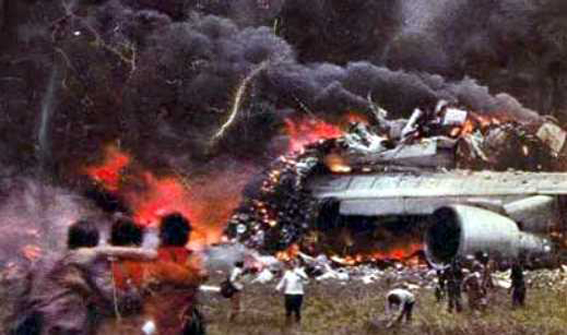
Pan Am survivors have emerged from the fiery inferno
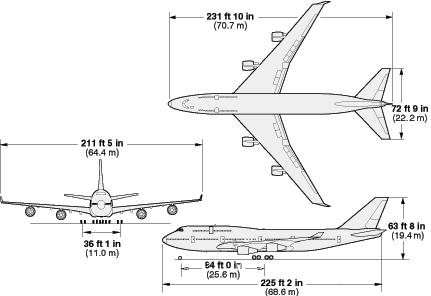
Dimensions for Boeing 747- 400.

The crew on the Pan Am plane had discovered that the KLM plane was on a collision course. They tried to turn left to get off the runway but it was too late. The KLM plane's engine no. 1 (on the right wing) touched at the right side of the Pan Am plane. The KLM plane's front landing gear missed the Pan Am plane. The KLM plane's rear landing gear hit the Pan Am plane in the area at engine no. 3 (on the left wing). Investigators found tracks in the runway that the rear of the KLM plane tore up before the collision. This means that the pilots on the KLM plane managed to get up the nose of the plane but that the tail never left the runway. The take-off distance used by the fully-fueled KLM plane up to the collision site was 1370 m. The normal take-off distance for the Boeing 747 is about 3000 m. Great action by the KLM pilots as they tried to get the plane up.
Shortly after the collision, the KLM plane hit the runway and caught fire. It slides on the runway about 450 m before it stopped. Both planes were totally destroyed due to fire. All 248 on the KLM plane were killed. On the Pan Am plane, 335 were killed and 61 survived. It was not possible to carry out any autopsies on the crew of the KLM plane due to the status displayed by their bodies. A total of 583 fatalities making this disaster the largest in aviation history.
So far the official version of the Tenerife airport disaster. I have examined this event in more detail on the assumption that it is part of the war on semen.
In the fall of 1975, I and my travel mate made a charter trip to Tenerife. One of my photos shows that we flew with a Boeing 727. We rented a car and did some tours on the island. We visited the top of the mountain massif Teide. In connection with this tour, I took this photo:
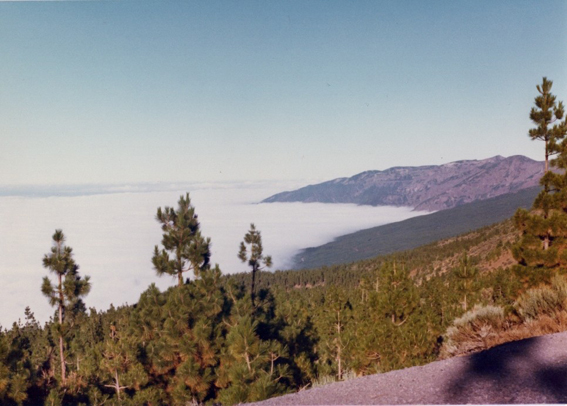
Here you can see how the cloud base lies along the mountain slopes. It was a strange feeling to be above the clouds in this way. I told about this trip to a number of people upon returning to Stockholm. Without a doubt, the CIA got the idea for the operation at Los Rodeos from these pictures. The operation is thus V-marked from the first moment. At the time of the disaster, I lived in Chicago. I had previously informed my surroundings that I would move back to Stockholm in June 1977.
A prerequisite for the operation was that there would be fog at the airport. Its task was to act as a contributing cause of the disaster and to delay the visual contact between the planes during the collision - as far as possible. Some of the private investigators who examined the "accident" have found too many coincidents to make the accident scenario fit. The Pan Am was supposed to leave the runway at the exit to taxiway C3. Nevertheless, they continued towards C4. Why? Could Pan Am have missed C3 because the visibility was too bad? The runway has a width of 45 meters. Suppose they were at the center line of the runway when they were taxiing, they could see C3's entrance at a distance of 22 - 23 m. KLM's Captain, Jacob Veldhuyzen van Zanten, was pointed out as responsible for the disaster. He was 50 years old and had 11,700 hours of flying time behind him, of which 1,545 hours on Boeing 747. He was a front figure within KLM. He was in charge of educating KLM's pilots. He is accused of having taken-off without getting a clearance from the Tower. How could he make such a mistake?
When the disaster was to be investigated, it was the authorities in Spain, the Netherlands and the United States who got the matter on their tables. The main responsibility lay on Spain as the disaster occurred on Spanish territory. After a few months, a dispute ensued between the investigating parties. The investigation took on the character of a blame game. After about a year, they had decided to point out Captain Veldhuyzen van Zanten as the scapegoat. KLM declared itself ready to take the financial responsibility to compensate those affected.
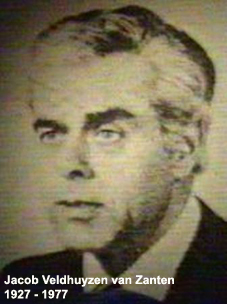



Jacob Veldhuyzen van Zanten Marcus Wallenberg Marcus Wallenberg Jacob Veldhuyzen van Zanten
(1927 - 1977) (1899 - 1982) (1899 - 1982) (1927 - 1977)
The central parts of the accident reports revolve around the radio communication between the air traffic controllers and the two planes. This is where the explanation for the disaster is supposed to be. Unfortunately, the conclusions drawn in the reports are misleading as the CIA manipulated the radio communication.
For safety reasons, the radio communication between the air traffic controllers and the crew of the aircraft is recorded. Communication between people in the crew (cockpit) is also recorded. The recording notes which microphones the recording was from. The device on which the communication is stored is called Cockpit Voice Recorder (CVR). Another unit records the pilots' use of the controls in the cockpit. Throttle, brakes, rudders, etc. are recorded. This device is called Flight Data Recorder (FDR), or popularly the "black box". The units are designed to withstand mechanical and fire effects. In addition to these units, communication between the air traffic controllers and the planes is recorded on a unit in the Tower. In the 1970s, recording was done on so-called. magnetic tape (analogue recording).
Three air traffic controllers worked in the Tower. One was responsible for communication with oncoming flights. The radio frequency used was 119.7 Mhz. Another was responsible for communication with departing flights. The radio frequency used there was 118.7 Mhz. The third controller acted as a backup.
When you read the accident reports' prints of what CVR recorded, you get the impression of stress and uncertainty. This mode has been deliberately created by the CIA. The purpose of the manipulated radio communication was to discredit the crews of the planes. When the investigators listened to the recordings or read the printouts, they could conclude that "pilot error" occurred.
The technology used by the CIA to manipulate radio communications is called "jamming". It was originally developed for military purposes. A “jammer” is a device that acts as a radio transmitter. Once you locate the enemy's radio frequency, you can send out signals to disrupt the communication. You can send out different types of sounds that you pre-recorded, such as screaming sounds, music and speech - all to confuse the enemy. A “jammer” can also block all communication on a certain radio frequency. It can be said that the "jammer" controls the communication at the current frequency. This type of radio transmitter is prohibited for private individuals.
The concept used by the CIA in the Tenerife disaster is similar to that used in the train accident at Akkavare in 1956. My assumption is that the CIA used a "jammer" at Los Rodeos. In preparation for the operation, the air traffic controllers have been under surveillance and recorded. Their communication with the planes that have landed has been recorded. The CIA has then hired a voice imitator who trained on their voices. The imitator has been instrumental in recording some of the phrases that would be used when Pan Am and KLM would launch at Los Rodeos. Example: “KLM four eight zero five you are cleared for take-off.” The phrases have been sent out by the CIA's "jammer" without the air traffic controllers noticing. A voice imitator may also have been "live" on location at Los Rodeos. It is likely that the operation had backup from a mobile ground radar. Its task was to locate the position of the planes on the taxiways and the runway.
After analyzing the radio communication that exists, my opinion is that the collision site at C4 was predetermined. The transcripts show that Pan Am was ordered to descend to C3 and leave the runway there. This instruction is repeated and reminded several times. My suspicion is that this part of the communication is manipulated. The order that Pan Am received was to taxi down to C4. One reason was to place the collision site as far away from the terminal as possible. Another was that KLM's take-off distance would be about 370 m shorter compared to C3 as the collision site.
What was recorded on CVR in the two planes has also been recorded by the Tower. This meant that the CIA's (voice imitator) take-off clearance for KLM was recorded by the Tower. The CIA was aware of that the radio communications stored on the planes' CVR and at the Tower would be examined by the investigators. The CIA therefore ensured that their agents seized the recordings. The CIA copied the existing communication. Then they have edited the content. They have deleted the phrase "KLM four eight zero five you are cleared for take-off." It is likely that the CIA (the imitator) had instructed the Pan Am to proceed to C4 as they approached C3. This instruction has been deleted. (Pan Am's captain, Victor Grubbs, survived the crash. He was the one who could say how it was related to C3 and C4). Subsequently, the CIA has made two new CVR units with exactly the same appearance as the original ones. The ID numbers found on the cover of the original units have been inserted on the new ones. They then copied the edited radio communication to the new CVR. It was relatively easier to replace the magnetic tape of the Tower since it was not stored in any enclosure. The manipulated material was then handed over to the investigators.
Accident Reports:
| Netherlands Aviation Safety Board | finaldutchreport.pdf | (5.4 MB, english) |
| Air Line Pilots Association (ALPA) | alpa.pdf | ( 2.8 MB, english) |
| Part One of the Spanish Report | Spanish_report.pdf | (english) |
| Part Two of the Spanish Report | spanish_report2.pdf | (english) |
| Annex 1A | los_rodeos_anexo1A.pdf | |
| Annex 1B | los_rodeos_anexo1B.pdf | |
| Annex 2 | los_rodeos_anexo2.pdf | |
| Annex 3 | Anexonumero3.pdf | |
| Annex 4 | los_rodeos_anexo4.pdf | |
| Annex 5 | Anexonumero5.pdf | |
| Annex 6 | los_rodeos_anexo6.pdf | |
| Dutch Comments on the Spanish Report | Dutch_comments.pdf | (english) |
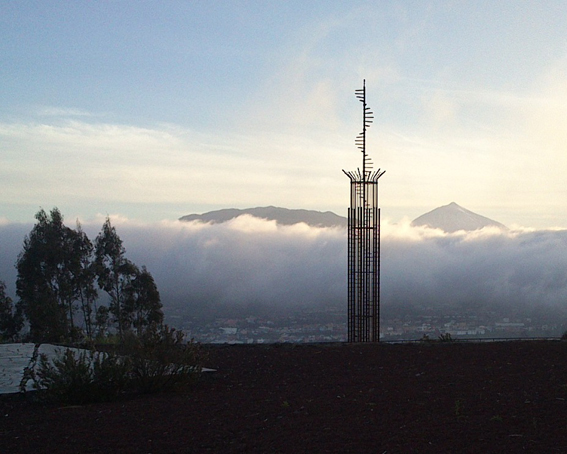
A memorial over the victims of the disaster has been erected . It's called the
International Tenerife Memorial. It is located on Mesa Mota on the outskirts of
San Cristóbal de La Laguna. Behind the memorial you can see the cloud
base and the top the mountain massif Teide.
Coordinates: 28.5069° N, 16.3183° W
YouTube Video: Carpenters - Top of the World. (1972)